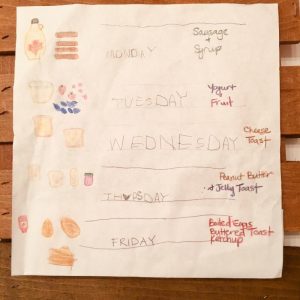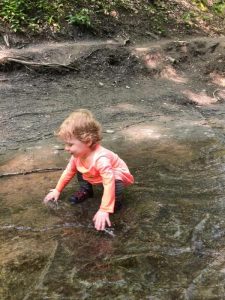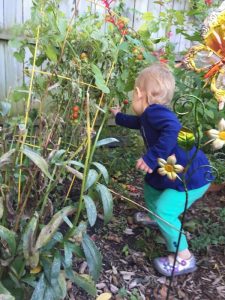One of my favorite lessons from Steiner is the value and faith in feminine knowing – the knowledge that you have within yourself, not dictated from wise instructors. This beautiful reminder often inspires me to seek answers within myself when I might otherwise hope some wise teacher or friend will enlighten me. So, too, with this topic of Goodness. In addition to asking how to raise children with a sense of trust that the world is fundamentally good, it is worth asking yourself, “What is Goodness?” to you! This is a creative and celebratory process that allows your values to show themselves. As you define Goodness for yourself the answers for how to teach goodness may begin to show themselves to you.
Goodness for me is that the world is fundamentally gentle, kind, beautiful, and joyful. It is also that the world is predictable, consistent, and safe. Goodness is also that we are all in this together – collaborating (with each other and with nature) to create the world we want to live in.
While as adults we know that the world is not ALWAYS Good in this way. But the task as adults is for us to nurture the inner knowing that there is a strong inner heart of Goodness in the world. This provides fuel for hope, resilience, and fortitude when harsh realities present themselves.
From this perspective here are some examples of how we can share Goodness with children and each other!
Sharing Goodness at Mealtimes. Lighting a candle at a meal is a wonderful way to signal that you are sharing something special together. Saying a blessing at a meal allows us to share reverence for the food and the company, and is a wonderful way to introduce gratitude. The rhythm and rhyme of most blessings are so enchanting to children that, with regular use, the kids will remind YOU to say the blessing.
 Having a standard family menu creates consistency and predictability for children. Knowing what will happen, being able to count on that thing happening – this is Goodness for all of us, but especially young children. At our Lifeways center in town, the snacks and the meals are set by the day. (Pasta on Tuesday, Soup on Wednesday, etc…) At home, picking just one meal and even a few days each week is a really good way to start. Every couple months we pick 3-4 dinners that we have each week on the same day. Knowing that this routine is just for a couple of months is helpful for my husband and I since we both like to cook and eat new foods. We worried we might bore of this routine but actually take pleasure in the way it reduces the decision making load on us as we shop and make dinner each night. Delightfully, our girls began to enjoy the food more as we regularly served the same thing.
Having a standard family menu creates consistency and predictability for children. Knowing what will happen, being able to count on that thing happening – this is Goodness for all of us, but especially young children. At our Lifeways center in town, the snacks and the meals are set by the day. (Pasta on Tuesday, Soup on Wednesday, etc…) At home, picking just one meal and even a few days each week is a really good way to start. Every couple months we pick 3-4 dinners that we have each week on the same day. Knowing that this routine is just for a couple of months is helpful for my husband and I since we both like to cook and eat new foods. We worried we might bore of this routine but actually take pleasure in the way it reduces the decision making load on us as we shop and make dinner each night. Delightfully, our girls began to enjoy the food more as we regularly served the same thing.
“Mmmmm, this is so yummy!” If you don’t yet have the habit of appreciating goodness verbally, or have fallen out of the habit, being around children is a wonderful invitation to relearn this skill. When someone prepares delicious food it is downright FUN to appreciate it expressively and dramatically! It brings a smile to everyone’s face to have someone enjoy enthusiastically! (In a similar way, getting down on the ground and in a dramatic whisper pointing out a beautiful colored leaf in autumn or discovering an acorn with wonder, “Oh, wow, look at this acorn!” shows children the Goodness of acknowledging Goodness! A note of caution – LOTS of talking can be at cross purposes to communicating with children. Simple, short, and expressive phrases are ideal.)
A nurturing bedtime routine, offering a particular set of activities in a particular order, helps tremendously to ease bedtime stress. Goodness is demonstrated when we provide sources of comfort for transition times, such as the transition between wakefulness and sleep. It may not immediately make bedtime stress-free, but over time the familiarity will grow into comfort.
Retelling the day’s events at night before bed reinforces that we have shared an experience. There will have been joys, upsets, beauty, messes, predictability and surprises. And this is a nod to the more complex reality of Goodness that we all know as adults, in a form that is appropriate for young children and not burdened by adult concerns. That you’ve arrived at the end of the day and can share these experiences together – quietly, calmly, with some distance – this is Goodness. Plus, children love to hear about their day – either directly or in a story form told about “a little girl about your age…”
Saying “thank you”, “please” and “you’re welcome.” Courtesy is one of the Good things we do to share how we value our supportive relationships with each other. Your children will imitate you naturally. Using pleasant manners whenever you get the chance is more important than any other “technique” for teaching pleasant manners as a sign of care and respect. This is also pleasant for you and the other people you interact with!
Another form of courtesy is greeting acquaintances. If you are fortunate enough to see familiar faces, even if not close friends, it is a delight to be forthcoming in acknowledging their familiarity. This is the Goodness of community. If you do not know their names or can’t recall where you last met them, still say hello with a warm smile, and introduce yourself again if you have the opportunity. In my experience, if I choose to bashfully look away from someone I recognize but don’t really know that well, they will do the same. If I send them a hearty greeting, they have always responded in kind and seem pleasantly surprised. I have recently been inspired to keep up this tradition as a model to my girls of the Goodness in offering a friendly smile and hello.
Silliness. Being silly is a Good thing, and not taking yourself too seriously opens up a world of joy, playfulness, creativity, and vulnerability that embody Goodness. One of my girls’ favorite things is when I talk in an accent with funny phrases that we don’t usually use – any old accent will do and they don’t care (or know) how “good” I am at it.
There is a lot of Goodness to be found outdoors. Whether it be the pleasure in moving your body, feeling sunlight, wind, rain, or snow on your cheeks, or in the delights that you can find out in nature – like moss, leaves, acorns – being outside is a great way to encourage and invite Goodness for your children to see. Celebrating the seasons and other rhythms in nature show us that, while there is constantly change, there are consistent, predictable patterns in many of the changes we experience.
 Dressing just right for the weather allows children to enjoy the outdoors without physical discomfort. In any and all weather, nature has something magical, joyful and delightful to offer. In order to observe the Goodness of nature, we must be dressed comfortably and appropriately. Children have not yet developed a good sense of what they need for physical comfort and protection, so it is up to us adults to insure that the children are dressed right for the temperature outdoors.
Dressing just right for the weather allows children to enjoy the outdoors without physical discomfort. In any and all weather, nature has something magical, joyful and delightful to offer. In order to observe the Goodness of nature, we must be dressed comfortably and appropriately. Children have not yet developed a good sense of what they need for physical comfort and protection, so it is up to us adults to insure that the children are dressed right for the temperature outdoors.
Seeing where food comes from. It is Good that the earth provides for us and that the work of farmers turns the land into delicious nourishment. In this same way, planting and growing food to eat is a beautiful thing to do with children.  You don’t need a lot of space or a particularly green thumb. Consider starting with a container with basil and parsley, or a strawberry pot to grow strawberries. If you are more ambitious and have a sunny spot, plant two blueberry bushes of your own!
You don’t need a lot of space or a particularly green thumb. Consider starting with a container with basil and parsley, or a strawberry pot to grow strawberries. If you are more ambitious and have a sunny spot, plant two blueberry bushes of your own!
Creating and tending a nature table. The nature table can be a wonderful place to acknowledge the seasonal rhythm of the earth. The magic of finding natural objects outside and bringing them in to be celebrated on the table is a great way to honor the way our children already see the outside world with such open and fresh eyes. As an adult you may enjoy learning about the symbols, traditions, and mythologies of the seasons and sharing some of these through the nature table.
 Creating time for free play allows a child to play uninterrupted – with minimal corrections and few things that require a strong (or soft) “no.” This allows the child’s ideas to flow naturally and teaches her to have confidence in her abilities to explore, problem solve, come up with an idea, and act her idea out. A space where precious, fragile, or dangerous things are not an issue and where just about any idea is acceptable is a gift of Goodness you give to your children.
Creating time for free play allows a child to play uninterrupted – with minimal corrections and few things that require a strong (or soft) “no.” This allows the child’s ideas to flow naturally and teaches her to have confidence in her abilities to explore, problem solve, come up with an idea, and act her idea out. A space where precious, fragile, or dangerous things are not an issue and where just about any idea is acceptable is a gift of Goodness you give to your children.
Simplifying. After a long session of decision making we all experience decision fatigue. This is a phenomena where our decisions decline in quality and become increasingly irrational. Don’t be alarmed if this describes a 3-year-old you know. Some decisions are required – learning to share and interact with other children requires all sorts of decisions. The good news is that we can greatly reduce the number of unnecessary decisions our children are faced with by offering fewer books, toys, clothes, and choices. A handful of toys is enough for children to engage with fully. If you have many more, create a toy library you can borrow from when you, or your children, are ready for something new. You will probably crave new toys and books before your children do – here the Goodness of predictability and consistency plays out for them as well.
Doing work. Goodness is a space that is well cared for, peaceful, and beautiful. But places need us to nurture them just like people do – a well lived in and loved house, center, or outdoor space feels different than a haphazard, chaotic or neglected one. Our homes and gardens take care of and protect us, so in taking care of these spaces we reciprocate for this service. Caring for the home and all the beings in it, making your space beautiful and peaceful, models Goodness. Just seeing you do work with engagement, attention and even pleasure is an important method of teaching Goodness. Children will inevitably want to participate.
Take care that children are wise beings. They can tell the difference between real contribution and busy work, so it’s useful to spend some time thinking about what real work your children might help with – watering plants, moving a wood pile, digging in the soil, delivering a note to a neighbor, washing the floor, measuring ingredients, or dusting. When you set aside extra time to do some of these tasks with children as helpers, you will no doubt rediscover some of the Goodness in them. For instance, a warm sudsy bucket of water for washing the floor can feel so good on your hands. It can be quite fun to greet your plants as you inspect them, spraying them with water. A friend of mine, when she is wanting to reconnect with her house makes a point of going around and touching everything to reconnect the objects with her energy, and revisit her intention in having these objects out for view – a nice take on dusting!
Marijke Kemble is mother to 2 daughters – Marnie Willow (5) and Olive Celeste (2.5) and lives in Buffalo, N.Y. with her husband Dennis. She seeks to find meaning, purpose, and clarity in the world, and in daily life. She believes together we can do all the things – Big Things, Small Things, Hard Things, Funny Things, Sad Things, Joyful Things. She writes about this journey in her bi-monthly email newsletter.